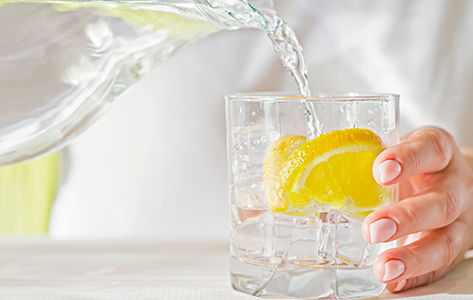Be Proactive About Your Health
To stay safe and healthy, it's good to have a primary care provider who knows and understands your health history and wellness goals.

When you think of summer, you probably envision backyard barbecues, swimming pools, or a much-needed vacation. You probably don’t think of kidney stones — but maybe you should.
Summer is stone season. As temperatures rise, so does your risk of developing kidney stones. Why is that, and how can you protect yourself?
Naeem Rahman, MD, a urologist with Atlantic Health System, explains why kidney stones are more common during the summer months and shares easy ways to decrease your risk of developing a kidney stone this summer — or any time of the year.
What is a Kidney Stone?
A kidney (renal) stone is a small, hard deposit of crystallized mineral and acid salt that forms when your urine becomes too concentrated. While there are different types of kidney stones, most are calcium-based, meaning they are comprised of excess calcium that your body cannot use.
Kidney stones can form anywhere along your urinary tract —that is, the kidneys, bladder or ureter (tube connecting your kidney and bladder) — and vary in size. They can be as small as a grain of sand or as big as a golf ball.
Who Gets Them?
Roughly 1 in every 10 Americans will see a doctor for kidney stones, which means they are pretty common. And while it used to be considered a male disease, both men and women can develop kidney stones.
According to Dr. Rahman, certain factors increase your risk, including:
- Diet and fluid intake (eating too much sodium (salt), calcium, and/or meat and not consuming adequate amounts of water)
- Personal history (having had a previous stone)
- Family history (immediate family members have had stones)
Additionally, some anatomical issues and metabolic or genetic defects and diseases (such as diabetes, obesity, recurring urinary tract infections or UTIs) can cause higher concentrations of calcium in the body, making you more prone to stone development. The same is true for people who have had gastric bypass surgery or take certain medications, like those used to treat high blood pressure and migraine headaches.
What Does a Kidney Stone Feel Like?
When a kidney stone moves along the ureter (tube connecting the kidneys and bladder), it causes an obstruction. Because urine is still being made, your kidney stretches, causing intense pain.
“Often times, patients end up in the emergency department because the pain is so intense,” Dr. Rahman says.
The Three Most Common Symptoms:
- Sharp, intense pain that starts in the flank (left side, just under your ribs) and causes nausea.
- Blood in your urine (although Dr. Rahman says that this may be microscopic and not visible without a microscope).
- Urinary tract infections (UTIs) and/or burning with urination.
Why are Kidney Stones More Common During the Summer?
The number one reason, according to Dr. Rahman, is dehydration. Most of us do not drink enough water. Add in summer heat and humidity, and our general need for water increases.
“Many of us are spending more time outdoors in the sun and we forget to drink enough water,” says Dr. Rahman. “Proper hydration is necessary for so many of our bodily functions, and it’s essential for warding off kidney stones.”
Another reason why kidney stones are more common during the summer may be the increase in vitamin D we receive.
As Dr. Rahman explains, sun exposure increases our levels of vitamin D, which is a good thing. But too much vitamin D (especially if you are already supplementing) can be harmful. Vitamin D raises calcium absorption. Your body can only absorb so much calcium, so the excess gets eliminated through the urinary tract. Increased calcium in your urine may lead to the development of kidney stones if your kidneys cannot expel it fast enough.
If you don’t want kidney stones to be part of your summer memories, stay hydrated. If you’ve had kidney stones in the past, or if you have other risk factors, be extra diligent. As Dr. Rahman reminds us, proper hydration is important year-round for our bodies to function efficiently, but it’s even more important in warmer weather. “Good health in the summertime means more water for everyone.”
How Can You Reduce Your Risk of Kidney Stones?
While you cannot change your family history, anatomy or genetic makeup, there are things you can do to reduce your risk of developing kidney stones. The three simplest action steps you can take are:
- Increase your water intake.
- Eat more citrus fruit.
- Reduce or eliminate sodium (salt) and salty foods, like processed meats.
“The number one thing you can do to reduce your risk is to drink more water,” says Dr. Rahman. “I advise patients to drink at least 2-1/2 liters (8 cups) of water every day. More — upwards of a gallon (16 cups) — if they have a history of kidney stones or other risk factors.”
Dr. Rahman also urges people to increase their citrus fruit consumption because “citrate binds to calcium, so there’s less calcium available to form into stones.” Lemons, grapefruits and oranges are all good choices. To kill two birds with one stone, so to speak, squeeze a full lemon into your half or full gallon jug of water, and you’re good for the day.
As for those grilled hot dogs and salty summer treats, Dr. Rahman says to practice moderation. “I’m not saying you need to avoid them completely, but you should be aware of the sodium content in your food.”
Be Proactive About Your Health
To stay safe and healthy, it's good to have a primary care provider who knows and understands your health history and wellness goals.